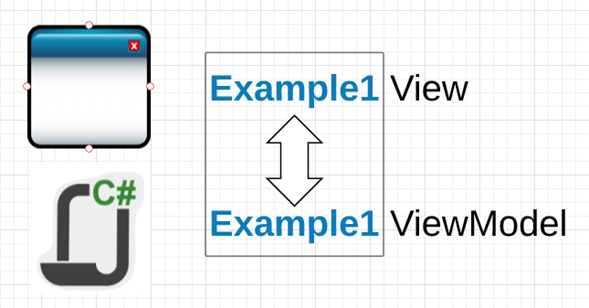AutoViewModel
AutoViewModel is a Fluent MVVM features to auto instantiate our
ViewModels classes. Its objective is simplified as far as possible ViewModels classes with same performance and stability.
AutoViewModelmark> isn’t mandatory, so that we can use any other technique.
AutoViewModelmark> has a basic rule that showing the following image.

The
View class name and the ViewModel class name have to be the same preceded by suffix View for the View class and ViewModel for the ViewModel class.
- SameNameClass[View].xaml / cs
- SameNameClass[ViewModel].cs
A Example
- MyView.xaml / cs
- MyViewModel.cs
ViewModel class following the general autoInstace rule so that, its name will be MyViewModel.cs.
AutoViewModel Class
AutoViewModel.cs class is a Fluent MVVM ViewModel instance control class. It is in MoralesLarios.FluentMVVM.Infrastructure namespace and is a static class with 2 AttachDependency properties.
- IsAutoMaticViewModelInstance
- Is a
boolproperty,falseis its default value. If this property istrue, AutoViewModel engine will try to instantiate its ViewModel class referred (this class must comply with the previous main nomenclature rule). If isfalse, it will do nothing. - ViewModelClassName
- Is a
stringproperty. If your ViewModelClass doesn’t follow the main nomenclature rule, you set the ViewModelClass name in this property.
Internal Class Search Rule
When AutoViewModel engine search ViewModelClass to instantiate, follow the next rule:
In the case we have added an

In the case we have added an
IoC in our project, this will be the first place to search. If there isn’t IoC or ViewModelClas isn’t in the IoC configurations types, The AutoViewModel engine search in all project. This rule is valid to two different searches (IsAutoMaticViewModelInstance and ViewModelClassName).

Important: If you don’t setup your
ViewModel class in IoC, your ViewModel class a constructor without parameters.
Examples
This are 4 types
Our example has an initial Fluent MVVM configuration only with
We will build 2
Will change
We show
AutoViewModel configuration. We will create an example for each.
Our example has an initial Fluent MVVM configuration only with
nuget package and IoC configuration. For more info QuickStart and Multi IoC sections.
We will build 2
Views and 2 ViewModels, a couple for those who comply with nomemclature rules and another for those who don’t comply.
Will change
IoC configuration to demonstrate it has preference over another project classes.
We show
IoC Fluent MVVM configuration with empty instances registered.
using Autofac; using MoralesLarios.FluentMVVM.Infrastructure.IoC; using System; namespace FluentMVVMExamplesDesc.AutoViewModelApp.IoC { class BootStrapper : IContainerIoCWorker { public IContainer Container { get; private set; } public void RegisterTypes() { var builder = new ContainerBuilder(); // Empty Container = builder.Build(); } public object ResolveObject(Type type) { if (type == null) return null; object result = null; result = Container.TryResolve(type, out result); return result; } public T ResolveType<T>() { if (type == null) return null; T result = default(T); Container.TryResolve<T>(out result); return result; } } }
Example 1: ViewModel class with nomenclature rule without IoC
-
The first step is add a simple
WPF Window ViewWithRuleView.xaml .
-
The second step is add
ViewModelWithRuleViewModel.xaml . -
Completed code in WithRuleView.xaml .
<Window x:Class="FluentMVVMExamplesDesc.AutoViewModelApp.WithRuleView" xmlns="http://schemas.microsoft.com/winfx/2006/xaml/presentation" xmlns:x="http://schemas.microsoft.com/winfx/2006/xaml" xmlns:d="http://schemas.microsoft.com/expression/blend/2008" xmlns:mc="http://schemas.openxmlformats.org/markup-compatibility/2006" xmlns:local="clr-namespace:FluentMVVMExamplesDesc.AutoViewModelApp" xmlns:fluent="clr-namespace:MoralesLarios.FluentMVVM.Infrastructure;assembly=MoralesLarios.FluentMVVM" fluent:AutoViewModelClass.IsAutomaticViewModelInstance="True" mc:Ignorable="d" Title="WithRuleView" Height="359" Width="602"> <Grid> </Grid> </Window>
AS we can check it meets naming rule.

WithRuleViewModel.cs code.
namespace FluentMVVMExamplesDesc.AutoViewModelApp.ViewModels { using MoralesLarios.FluentMVVM; public class WithRuleViewModel : ViewModelBase { public WithRuleViewModel() { } } }
ViewModel class automatically.
Result.

When we auto instantiate non IoC setup classes, these classes have to be parameterless constructor, otherwise, they will throw an exception.

All process in video.
Example 2: ViewModel class with nomenclature rule with IoC
To give more value to example, we will add a dependency injection in our
ViewModel.
public class WithRuleViewModel : ViewModelBase { private readonly IMyInjection _myInjection; public WithRuleViewModel(IMyInjection myInjection) { _myInjection = myInjection; } }
In this moment will add our
WithRuleViewModel and MyInjection classes in IoC configuration. With this action
public void RegisterTypes() { var builder = new ContainerBuilder(); builder.RegisterType<WithRuleViewModel>().AsSelf(); builder.RegisterType<MyInjection>().As<IMyInjection>(); Container = builder.Build(); }
Result.

All process in video.
Example 3: ViewModel class without nomenclature rule with IoC
It’s time to add a new
View and a new ViewModel. For these new examples don’t must not comply the nomenclature rule.
-
The first step is add a simple
WPF Window ViewWithoutRuleView.xaml .
-
The second step is add
ViewModelNoRuleViewModel.xaml . -
Completed code in WithoutRuleView.xaml .
<Window x:Class="FluentMVVMExamplesDesc.AutoViewModelApp.WithRuleView" xmlns="http://schemas.microsoft.com/winfx/2006/xaml/presentation" xmlns:x="http://schemas.microsoft.com/winfx/2006/xaml" xmlns:d="http://schemas.microsoft.com/expression/blend/2008" xmlns:mc="http://schemas.openxmlformats.org/markup-compatibility/2006" xmlns:local="clr-namespace:FluentMVVMExamplesDesc.AutoViewModelApp" xmlns:fluent="clr-namespace:MoralesLarios.FluentMVVM.Infrastructure;assembly=MoralesLarios.FluentMVVM" fluent:AutoViewModelClass.ViewModelClassName="NoRuleViewModel" mc:Ignorable="d" Title="WithoutRuleView" Height="359" Width="602"> <Grid> </Grid> </Window>
AS we can check it don't meets naming rule.

WithoutRuleViewModel.cs code.
namespace FluentMVVMExamplesDesc.AutoViewModelApp.ViewModels { using MoralesLarios.FluentMVVM; public class WithoutRuleViewModel : ViewModelBase { public WithoutRuleViewModel() { } } }
ViewModel class automatically.
Result.

When we auto instantiate non IoC setup classes, these classes have to be parameterless constructor, otherwise, they will throw an exception.
All process in video.
Example 4: ViewModel class without nomenclature rule with IoC
Same as in Example 2, to give more value to example, we will add a dependency injection in our
ViewModel.
public class NoRuleViewModel : ViewModelBase { private readonly IMyInjection _myInjection; public NoRuleViewModel(IMyInjection myInjection) { _myInjection = myInjection; } }
In this moment will add our
WithRuleViewModel and MyInjection classes in IoC configuration. With this action
public void RegisterTypes() { var builder = new ContainerBuilder(); builder.RegisterType<WithRuleViewModel>().AsSelf(); builder.RegisterType<NoRuleViewModel>().AsSelf(); builder.RegisterType<MyInjection>().As<IMyInjection>(); Container = builder.Build(); }
Result.

All process in video.
Download AutoViewModel (AutoViewModel proyect) Code

No hay comentarios :
Publicar un comentario